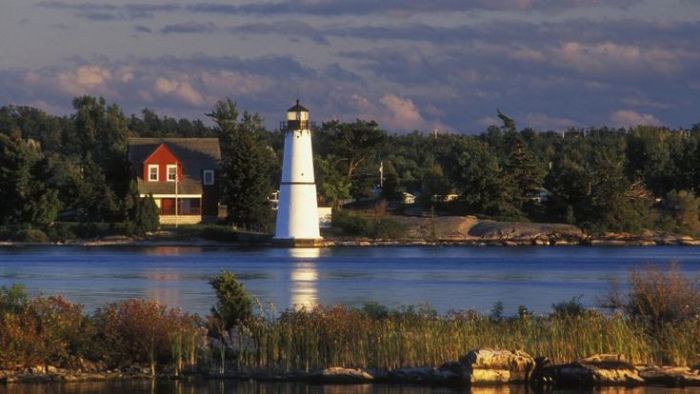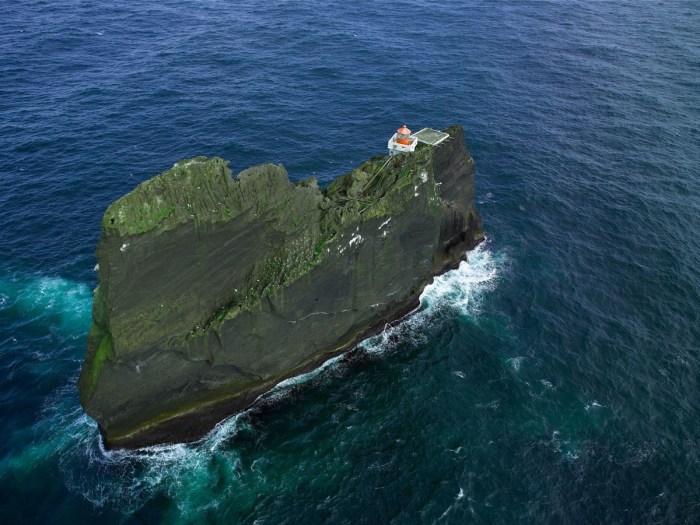A lighthouse is located on a small island, a solitary sentinel standing tall amidst the vast expanse of the ocean. Its beacon, a guiding light in the darkness, has served as a beacon of hope and safety for countless seafarers throughout history.
This isolated outpost is a testament to human ingenuity and the enduring power of maritime traditions. Its rugged terrain and unique ecosystem provide a captivating backdrop to the story of this iconic structure.
Island Description

The island on which the lighthouse is situated is a small, rocky outcrop measuring approximately 100 meters in length and 50 meters in width. The terrain is rugged and uneven, with steep cliffs rising from the water’s edge on all sides.
The island is largely barren, with sparse vegetation consisting primarily of hardy grasses and low-growing shrubs.
A unique geological feature of the island is a large sea cave located on its western side. The cave is accessible only by boat and is known for its impressive acoustics and the presence of rare marine life.
Lighthouse Architecture
The lighthouse is a cylindrical stone tower standing at a height of 25 meters. It is constructed from locally quarried granite and features a whitewashed exterior with red trim. The tower is divided into three sections: a base, a middle section, and a lantern room at the top.
The base of the lighthouse is solid and windowless, providing stability and protection from the elements. The middle section contains a spiral staircase leading to the lantern room. The lantern room is glazed with large windows and houses the lighthouse’s powerful Fresnel lens.
Lighthouse Purpose and Function
The primary purpose of the lighthouse is to aid navigation for ships passing through the treacherous waters surrounding the island. The lighthouse emits a powerful beam of light that can be seen for up to 20 nautical miles in clear weather.
The lighthouse’s light helps ships avoid the island’s dangerous cliffs and shallow waters. It also serves as a waypoint for vessels traveling along the coast.
Historical Significance

The lighthouse was built in 1850 to replace an earlier lighthouse that had been destroyed in a storm. It was constructed by a team of skilled stonemasons and engineers and took over two years to complete.
Over the years, the lighthouse has played a vital role in local history and culture. It has witnessed countless shipwrecks and rescues and has served as a beacon of hope for sailors navigating the dangerous waters of the region.
Environmental Impact: A Lighthouse Is Located On A Small Island

The lighthouse has a minimal impact on the surrounding ecosystem. The island on which it is situated is largely barren and devoid of significant wildlife. The lighthouse’s operation does not produce any significant noise or pollution.
However, the lighthouse’s bright light can disorient seabirds, particularly during migration periods. To mitigate this impact, the lighthouse is equipped with bird-friendly lighting that minimizes the amount of light pollution emitted.
Accessibility and Tourism

The island and lighthouse are accessible only by boat. Visitors can take a ferry from the mainland to the island, which takes approximately 30 minutes. Once on the island, visitors can explore the lighthouse and its surroundings.
The lighthouse is a popular tourist destination, attracting visitors from all over the world. It offers stunning views of the surrounding coastline and is a popular spot for birdwatching and photography.
Top FAQs
What is the primary purpose of a lighthouse?
Lighthouses serve as navigational aids, emitting powerful beams of light that guide ships and boats at sea, particularly during periods of darkness or poor visibility.
How does the lighthouse impact the surrounding environment?
Lighthouses can have both positive and negative environmental effects. They may attract birds, leading to increased bird populations in the area. However, the light emitted by the lighthouse can also disrupt bird migration patterns.